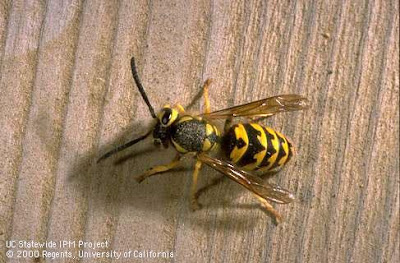
|
|
This is a western yellowjacket. They're beneficial
insects, but will sting if their nest is disturbed.
(Photo courtesy UC IPM)
|
Watch where you step; it’s yellowjacket season.
Late July and August are peak times for yellowjacket encounters, especially during a drought. As it searches for water sources, this familiar black wasp with distinctive yellow markings is more likely to fly into irrigated landscapes. Quite often, they’ll hang out on lawn as they search for grubs and caterpillars as well as moisture.
Because they eat so many destructive plant-eating insects, yellowjackets are considered very beneficial, and not a pest. Unless they start stinging.
Yellowjackets will sting – a lot – if their nest is disturbed. That likely was the case earlier this week when six tourists to the Sonoma Coast were stung repeatedly by yellowjackets after one of them fell into a nest near Goat Rock State Beach; the others were stung as they tried to help. Two women, ages 68 and 70, were flown to a local hospital.
Yellowjackets also are attracted to dropped fruit under trees. They like flower nectar (and help with pollination). With a craving for meat and sweets, their favorite “food” is people’s garbage; they’re known for buzzing trash cans – as well as outdoor picnics or barbecues.
Unlike paper wasps that build open-honeycombed nests in eaves and other protected spaces far above ground, yellowjackets like the cool of the earth. They opportunistically build their nests (which are enveloped in paper) in abandoned gopher burrows, gaps in walls or holes in the soil. Or they may make their home inside an irrigation valve housing – it’s cool and connected to its own water source.
One nest or colony may be home to hundreds, even thousands, of yellowjackets. Once yellowjackets discover a source or food or water, they’ll return often to hover at that location – even after the food is gone.
People usually can get along with yellowjackets as long as they respect their space, according to experts.
“In Western states, there are two distinct types of social wasps—yellowjackets and paper wasps,” explains the UC master gardeners. “Yellowjackets are by far the most troublesome group, especially ground- and cavity-nesting ones such as the western yellowjacket, which tend to defend their nests vigorously when disturbed. Defensive behavior increases as the season progresses and colony populations become larger while food becomes scarcer.
“In fall, foraging yellowjackets are primarily scavengers, and they start to show up at picnics and barbecues, around garbage cans, at dishes of dog or cat food placed outside, and where ripe or overripe fruit are accessible,” added the master gardeners. “At certain times and places, the number of scavenger wasps can be quite large.”
Cover your drinks. Scavenging yellowjackets have been known to crawl into soda cans and sting unsuspecting sippers.
“Paper wasps are much less defensive and rarely sting humans,” noted the master gardeners. “They tend to shy away from human activity except when their nests are located near doors, windows, or other high-traffic areas.”
In your home garden, be careful while weeding. It’s easy to unearth a nest while pulling tall grasses or step in an occupied hole. (Personally, I’ve done both.)
Because they are beneficial insects, yellowjackets have an important place in the landscape. “(They) should be protected and encouraged to nest in areas of little human or animal activity,” say the master gardeners.
“The best way to prevent unpleasant encounters with social wasps is to avoid them,” say the master gardeners. “If you know where they are, try not to go near their nesting places. ... Be on the lookout for nests when outdoors. Wasps that are flying directly in and out of a single location are probably flying to and from their nest.”
Keep garbage covered and, when eating outdoors, cover food and drink, too.
And watch where you step.
For more on yellowjackets and paper wasps:
http://ipm.ucanr.edu/PMG/PESTNOTES/pn7450.html
This page also has a helpful video on distinguishing yellowjackets from lookalike insects.

